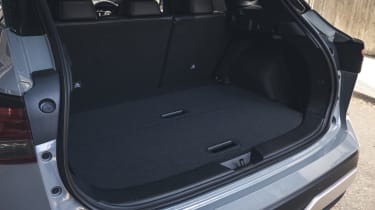Nissan Qashqai: old vs new
Is the latest Nissan Qashqai better than the popular previous-generation model? We find out
The Nissan Qashqai is a household name these days, and unlike models such as the Volkswagen Golf that have been around since the 1970s, its rise to stardom has been relatively recent. The Qashqai helped to kick-start the current SUV craze, especially because the first-generation model was ahead of its time with its bold looks and practical interior.
While that model is a bit too old to be found in regular service in 2021, you’re in luck – because a brand-new version has arrived this year. It’s packed with the latest tech, and Nissan will be hoping it can grab a slice of the family SUV market with the attributes that made it great before: a roomy cabin and striking exterior looks.
 The best mid-size SUVs – our 2025 top picks
The best mid-size SUVs – our 2025 top picks
However, the second-generation car might put a spanner in the works if you’re thinking of purchasing. The 2013-2021 car is available as a great-value second-hand car, so it might make an even better buy than the newer car for some people. We’re here to find out which is best for you. We’ll take a look at each aspect of both the old car (the previous-generation version) and the new one (which you can buy from Nissan dealers now) to help you decide which is best.
Design
The previous Nissan Qashqai has relatively angular looks, with chunky body cladding around the wheelarches plus roof rails and big alloy wheels to give it that desirable SUV look. It features a V-shaped front grille and LED daytime running lights for extra distinction from its rivals. When it first arrived in 2013 it was a stand-out option in its market sector, but by the end of its lifetime rivals such as the SEAT Ateca and Peugeot 3008 made it seem a little dull.
That’s not so for this new car, which has been brought right up to date. It still has the V-shaped grille, but it’s bigger and has a more modern look. There are LED headlights with a cut-out ‘C’ shape on either side of the grille, plus slices in the bumpers and doors and a two-tone roof. It’s one of the stand-out models in its class once again, although the Hyundai Tucson is arguably even more distinctive.
Interior and specs
The previous Nissan Qashqai went on sale in 2013, and back then we felt its interior was smart, well built and had plenty of technology. However, as newer rivals appeared, such as the superb Peugeot 3008, it started to look very dated, and the technology didn’t keep up, either. A 2017 redesign did help matters, but the previous-generation Qashqai’s interior was still functional and plain rather than interesting or luxurious.
Nissan’s new model has a much more distinctive interior design, and it makes more of a feature of the touchscreen display by having it mounted high up on the dash. It’s prominent, just as in many modern cars, but the main thing is that it’s far quicker to respond and easier to use than before, and it looks more modern as well. The materials inside the new car are better than they were previously, and things such as double-stitched leather on some models means it feels more upmarket. We’re pleased to report that Nissan has retained physical buttons and controls for important functions such as the climate control, which again allows easy use.
The good news with the previous model is that it was always well equipped. The touchscreen infotainment system didn’t always come with Android Auto and Apple CarPlay, but later models get this as standard – it’s worth checking to see whether a potential used buy has this included. Air-con was always standard, though, and useful functions such as folding mirrors were, too. Look out for the N-Connecta trim level, which came with a 360-degree camera for parking, 18-inch alloys, keyless go and (on auto models) Nissan’s ProPilot adaptive cruise-control system. Top-spec N-Motion models had heated seats and leather upholstery.
The current Nissan Qashqai range starts with Visia, which gets LED lights, auto headlights, DAB radio, Bluetooth and parking sensors. Acenta Premium includes two-zone climate control, an auto-dimming main mirror, keyless go and an eight-inch touchscreen with Apple CarPlay and Android Auto.
N-Connecta is available here, too, and comes with a digital instrument cluster, ambient lighting, around-view monitor, front parking sensors and online features for the touchscreen. The Premiere Edition adds a panoramic sunroof, head-up display and wireless phone charger.
Always popular Tekna trim comes with upgraded headlights and a powered tailgate, and Tekna+ features massaging front seats, Nappa leather upholstery and a Bose audio system. Adaptive cruise control, blind-spot monitoring, high-beam assist and traffic-sign recognition are all fitted as standard to every modern Qashqai.
Economy and performance
There was a decent selection of engines in the previous-gen Qashqai over the years, including petrol and diesel units. The diesels made the most sense in 2013 when the car was launched, so there will be plenty of used examples for sale. However, today they will appeal mainly to those doing motorway trips most of the time.
The best engine in the old Qashqai is the 1.3-litre petrol that was introduced later on. It came in 138bhp or 158bhp variants, but the former was the better pick as it had similar performance and economy for less money. Expect around 45mpg from this model, according to official figures.
The great news for new buyers is that this engine is still available in the latest model, in the same lower- and higher-power versions. There are manual and auto versions, plus two- and four-wheel drive. We think the latter isn’t needed, and it adds weight, too.
There are no diesels now, but an e-Power hybrid is on the way. It will use a 1.5-litre petrol engine teamed with an electric motor – we’re looking forward to trying it, because it should combine performance, economy and quiet running.
Practicality
The previous Qashqai was a really practical car, and it remains so today. It’s about the size of a Ford Focus, so it’s not too hard to park, yet it has a high driving position and plenty of headroom in the back seats – although legroom is a bit tight for tall passengers. It can tow a trailer of up to 1,500kg too, which could be useful for some buyers.
The old Qashqai has a 430-litre boot, which is good but not outstanding for its class; a similar Renault Kadjar has 527 litres, for example. The good news is that there’s a false floor which can be configured in different positions, as well as a wide opening for loading big items.
Nissan’s latest version has more room than before. Depending on the model you choose, there’s between 479-504 litres of space, which means it’s even more practical. There’s more rear passenger room in the new car, too, and although it’s a little bigger, it’s no more intimidating to drive. Fold down the rear seats and there’s 1,422-1,447 litres of space in total, again depending on the model you choose. Sadly it can’t tow as much as the old version – only up to 700kg.
Safety
The Qashqai has always been one of the safest cars in its class because of the plentiful safety kit that comes as standard. Euro NCAP awarded the 2013 model five stars in its crash test, plus the Nissan had stability control and other tech to improve stability in corners, and six airbags. Key active-safety kit such as ProPilot and autonomous emergency braking were not standard on all models, though.
While the new model hasn’t yet been tested by Euro NCAP, it has much more standard safety kit on every model. All models have blind-spot monitoring, tiredness alert, cross-traffic assist and autonomous emergency braking, plus the AEB comes with pedestrian detection and there’s a lane-keeping assist function, too. N-Connecta trim might be worth considering for its parking aids, which should help keep scrapes at bay.
Verdict
The new Nissan Qashqai is a big improvement over the previous model in a number of key areas. It’s more spacious than before, and rights the wrongs of the old car’s dreary interior with a hugely upgraded infotainment system, better materials and a more interesting design. It looks more modern on the outside, and comes with more safety kit as standard, too.
Yet the old car could still be a really good choice for some buyers. After all, it’s available with the same excellent 1.3-litre petrol engine as the new model, and will be much cheaper to buy as a second-hand car. If you can live with the dated interior, it’s practical enough for family life and decent to drive as well.
It might be with waiting for the upcoming hybrid Qashqai, though. It promises low running costs, especially as a company car, as well as quiet running and better performance.
Still need help deciding? Read our reviews of the latest Nissan Qashqai and the old Nissan Qashqai here.
Recommended

New Subaru Trailseeker revealed as rugged electric SUV with 375bhp

New Subaru Solterra brings more range, power and polish
Most Popular

New Smart #5 Brabus is a 637bhp far cry from the brand’s city car past

Best car leasing deals 2025: this week’s top PCH offers
Tips & advice

Car dashboard warning lights: what does each symbol mean?

Electric car charging stations: public networks, charger types, apps and maps
















